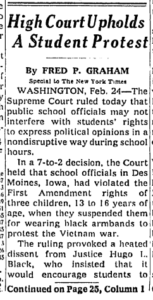Attorney Defending Free Speech in Schools
As the Supreme Court recognizes, “America’s public schools are the nurseries of democracy.” Mahoney Area Sch. Dist. v. B.L., 141 S. Ct. 2038, 2046 (2021). So it makes sense that students—like others in our democracy—enjoy the free-speech protections of the First Amendment. Generally, students have the right to protest, speak out, and wear expressive clothing. But there are some important limits on students’ right to free speech in schools.
Student First Amendment rights to political speech
 In 1969, the Supreme Court decided Tinker v. Des Moines Independent Community School District, a case involving three students suspended for wearing black armbands to protest the Vietnam war. In a landmark decision, the Court held that the First Amendment protected their expression, famously noting that students do not “shed their constitutional right to freedom of speech or expression at the schoolhouse gate.”
In 1969, the Supreme Court decided Tinker v. Des Moines Independent Community School District, a case involving three students suspended for wearing black armbands to protest the Vietnam war. In a landmark decision, the Court held that the First Amendment protected their expression, famously noting that students do not “shed their constitutional right to freedom of speech or expression at the schoolhouse gate.”
Tinker held that the First Amendment protects student free speech in schools unless it would substantially interfere with the operation of the school or invade the rights of others. Particularly when it comes to political speech, school officials must have a legitimate fear of disruption to prohibit student expression. In the words of the Tinker Court, “undifferentiated fear or apprehension” is not enough.
The Supreme Court has since carved out exceptions to Tinker’s broad rule. Schools may permissibly discipline profane or vulgar speech by students. Schools may also regulate speech that is sponsored by the school itself. For instance, a school may regulate the content of a school-run newspaper, if the school has a valid educational reason for doing so. And schools may also prohibit student speech that advocates illegal drug use.
Can schools prohibit student speech off campus?
Tinker concerned speech at school. What about student speech that takes place off campus? The Supreme Court addressed that issue in the 2021 case Mahoney Area School District v. B.L. In that case, the Court held that schools do not have the same authority to punish students for speech outside of school as they do for speech on school grounds. Even so, the Court held that the First Amendment doesn’t protect all off-campus student speech. For example, schools can discipline students for off-campus speech if it is “serious or severe bullying or harassment targeting particular individuals.” Schools can also prohibit “threats aimed at teachers or other students,” even if the threat is made off-campus.
Are student dress codes covered by the First Amendment?
Student dress codes can also raise free speech issues. The Supreme Court has held that free speech applies to nonverbal conduct that intends to communicate a message that would likely be understood by observers. This concept is known as “expressive conduct” and the Supreme Court has previously applied it clothing. Because students often seek to express themselves through the clothes they wear—as was the case in Tinker—dress codes can implicate free speech in schools.
But schools do have significant leeway to regulate student attire. Schools can restrict offensive or vulgar messages through dress codes. They can also restrict clothing that will cause a substantial disruption in the school. Courts make these determinations on a case-by-case basis and students typically need help from an Ohio free speech lawyer.
Lawyers protecting student First Amendment rights
When freedom of speech collides with the public-school setting, controversy often follows. Although courts have set down some markers, this area of law continues to develop, especially for online student speech. If you believe your right to free speech in schools has been violated, contact the Ohio free speech lawyers at Bolek Besser Glesius for a free consultation.

